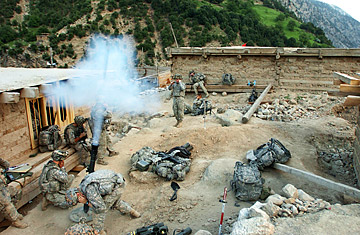
U.S. soldiers fire mortars during a combat operation in the village of Barge Matal in Afghanistan's eastern Nuristan province on July 12, 2009
Correction appended: Aug. 10, 2010
The brutal killing of 10 aid workers in a relatively tranquil part of northern Afghanistan late last week is a grim reminder that the Taliban-led insurgency's reach has expanded well beyond the movement's heartland in the south. The deadliest attack yet against foreign aid workers was also the second-largest loss of American civilians in a single attack in the nearly nine-year war, and comes at a moment when the Obama Administration is pushing for greater civilian involvement to help win over a distrustful public.
The ten-member international medical team — six Americans, two Afghans, a Briton and a German — were attacked while returning from a two-week trek into the wilds of Nuristan province, where they had provided free care to the impoverished residents of a remote mountain valley. According to Afghan police reports, they were accosted on a forested road in Badaskhan province by a band of militants who robbed them, lined them up and shot them one at a time. The lone survivor, an Afghan driver, was apparently spared by the gunmen after reciting Koranic verse. A Taliban spokesman claimed responsibility, alleging that those killed had been spies preaching Christianity. Officials of the International Assistance Mission, a Christian-supported program that has operated in Afghanistan since 1966, rejected the claim and insisted the project was purely humanitarian, noting that government permission was secured (the Afghan government does not allow religious proselytizing in aid missions) and that its activities were always conducted with the approval of local communities. In a statement posted on its website, the group condemned "this senseless killing of people who have done nothing but serve the poor."
The Taliban recently issued a revised code of conduct for its fighters, exhorting them to protect civilians, except for those who cooperate with Afghan security forces or foreign armies. Civilians are nonetheless dying in record numbers, mostly as a result of Taliban operations. And this is hardly the first time the movement has attacked foreign civilian aid workers. In August 2008, four workers with the International Rescue Committee were shot dead in a Taliban ambush outside of Kabul. Last month, gunmen and suicide bombers in the northern province of Kunduz stormed the offices of U.S.-based development organization DAI, killing at least five people. Once allowed to operate with a degree of immunity, aid workers now face a dramatically increased threat of kidnapping and assassination.
The deteriorating security situation for aid and development workers has cast a cloud over the Obama Administration's call for a civilian "surge" in southern Afghanistan, where the insurgency rages fiercest. Most foreign civilians still in the field there are contractors — or government employees — dependent on the military; the security threat has forced all but a few independent aid organizations to pull up stakes. Now, the threat has extended to swathes of territory in the north, where security has largely been taken for granted. Some U.S. military planners have begun to see the area as a second front, and NATO has deployed nearly 10,000 troops in the north this year — a 40 percent increase from 2009. Afghan officials say that militants are trying to extend their influence in provinces such as Baghlan, Kunduz, Badghis, Balkh and Takhar, where TIME recently reported on the unlikely genesis of a local Taliban commander. Last month insurgents in Baghlan managed to gain control of an entire district for two days after beheading six police officers. While the medical team killed last week had been advised that that Taliban were not active in the area of Nuristan where they were traveling, a network of other insurgent groups, chiefly the Hezb-e-Islami, have made it one of the most dangerous parts of the country. Until very recently, however, Badakhshan was known to be quiet.
Still, safety is always relative in any conflict zone. Prior to last week's attack, IAM had lost four staff in separate incidents over the years. Yet these risks did not deter team leader, Tom Little, 61, of Delmar, NY, an optomotrist fluent in Dari who had worked in Afghanistan for four decades. The Soviet invasion and civil war were not enough to keep him from raising three daughters in Kabul. His sober sense of commitment was shared by Thomas Grams, 51, who quit his Durango, CO, dental practice to give free treatment. Karen Woo, 36, a British surgeon who also gave up a steady job back home, wrote candid, upbeat blog posts detailing her hopes and fears as a newcomer. "The expedition will require a lot of physical and mental resolve and will not be without risk but ultimately, I believe that the provision of medical treatment is of fundamental importance and that the effort is worth it in order to assist those that need it most," she wrote in a posting ahead of the ill-fated trip.
At a Monday press conference in the capital, Dirk Frans, the director of IAM, insisted that his organization would press on with its work despite the huge loss and accusations of proselytizing. It's unclear what they will be able to accomplish, or how their mission will be revised. But given the combined risk of random and targeted violence against civilians that exists today throughout the countryside, it is harder than ever to deliver the kinds of services that many isolated and war-weary Afghans desperately need. Even for those determined enough to hike hundreds of miles on foot, unarmed into uncertain territory.
Correction: The original version of the story said that four workers with the International Committee of the Red Cross were shot dead in a Taliban ambush outside of Kabul. The four were with the International Rescue Committee.
Additionally, the story originally misstated the name of the aid team's leader as Bob Little. His name was Tom Little.
